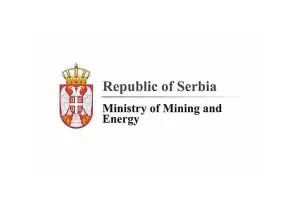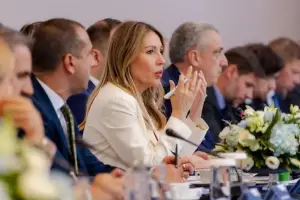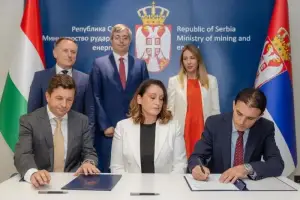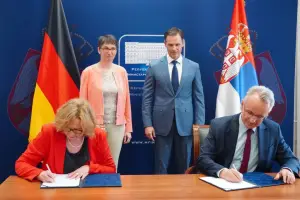Q:
A:
Foreign trade in 2007 grows 38.6%
Belgrade,
31 January 2008
The Serbian Statistics Office stated today that the total value of Serbia’s foreign trade from January to December 2008 was $27,175.2 million, an increase of 38.6% compared with the same period in 2006. Expressed in euros this figure is €19,790.9 million or 27.2% more than the same period in 2006.
Goods worth $8,824.8 million were exported, which is an increase of 37.3% compared with the same period in 2006. Goods worth $16,437.4 million were imported, which is a 39.2% increase compared with the same period in 2006.
Exports, expressed in euros, were worth € 6,432.2 million, which is an increase of 26.1% compared to the same period in 2006. Imports were worth €13,358.7 million, which is an increase of 27.7% compared to the same period in 2006.
Trade deficit stood at $9,525.6 million and is up by 41.2% compared the same period in 2006. Expressed in euros the deficit stands at €6,926.4 million, which is an increase of 28.6% compared with the same period in 2006.
The export to import ratio stood at 48.1%, compared to the same period in 2006 when it was 48.8%.
Increase of imports in the pervious period was a result of importing energy sources, which in the previous period was 17.3% of total imports, and copper and iron ore imports, whose market price on the global market is favourable, and in greater demand.
Increase in exports resulted from the privatisation and restructuring of companies carried out until now, as well as signed and ratified agreements on free trade with signatory countries to the Stability Pact, which are now unified under the single Central European Free Trade Agreement.
The increase was also due to the export of surplus agricultural produce, of which fruits and vegetables were worth $467 million, and food grains and related products $343 million. The agreement signed with the EU according to which Serbian textile products are given preferential status on the EU market also influenced this increase.
Aside from favourable global prices of products that Serbia imports, this positive trend was also influenced by the structure of the market as Serbia mostly exports to the euro zone while imports come mainly from the dollar area.
Regarding the make up of exports, the most notable were: intermediate goods 65.8% ($5,806 million), consumer goods 26.8% ($2,366.4 million) and equipment 7.4% ($625.4 million).
Regarding the make up of imports the most notable were: intermediate goods 60.8% ($11,160.6 million), then consumer goods 21.7% ($3,989.7 million) and equipment 17.2% ($3,200.1 million).
Major foreign trade partners in exports in the reference period were: Italy ($1,094.9 million), Germany ($1,042.1 million) and Montenegro ($950.9 million).
Major foreign trade partners in imports in the reference period were: the Russian Federation $2,625.9 million), Germany ($2,169.7 million) and Italy ($1,777.8 million).
Surplus was recorded in trade with Bosnia-Herzegovina, Montenegro and Macedonia. The largest deficit was in trade with Russia due to the import of energy, above all gas and oil and inadequate utilisation of the free trade agreement by Serbian importers.
According to the divisions of the Standard International Trade Classification (SITC) the following items had the greatest export share: iron and steel ($1,094 million), coloured metals ($694 million), vegetables and fruits ($467 million), clothes ($445 million), metal products ($426 million). These five sections accounted for 35.4% of overall exports.
The first five sections with the greatest share of imports were the following: oil and oil derivatives ($1,962 million), road vehicles ($1,503 billion), iron and steel ($917 million), industrial machines for general use ($881 million) and electric machines and equipment ($807 million) and these accounted for 33.1% of overall imports.
Among the first 100 products in exports and imports in December, at the top of exports were machines and devices ($30.5 million), refined sugar ($21.5 million); at the top of imports was oil ($131.9 million), gas ($88.2 million) and car vehicles ($51.4 million).
Exports, expressed in euros, were worth € 6,432.2 million, which is an increase of 26.1% compared to the same period in 2006. Imports were worth €13,358.7 million, which is an increase of 27.7% compared to the same period in 2006.
Trade deficit stood at $9,525.6 million and is up by 41.2% compared the same period in 2006. Expressed in euros the deficit stands at €6,926.4 million, which is an increase of 28.6% compared with the same period in 2006.
The export to import ratio stood at 48.1%, compared to the same period in 2006 when it was 48.8%.
Increase of imports in the pervious period was a result of importing energy sources, which in the previous period was 17.3% of total imports, and copper and iron ore imports, whose market price on the global market is favourable, and in greater demand.
Increase in exports resulted from the privatisation and restructuring of companies carried out until now, as well as signed and ratified agreements on free trade with signatory countries to the Stability Pact, which are now unified under the single Central European Free Trade Agreement.
The increase was also due to the export of surplus agricultural produce, of which fruits and vegetables were worth $467 million, and food grains and related products $343 million. The agreement signed with the EU according to which Serbian textile products are given preferential status on the EU market also influenced this increase.
Aside from favourable global prices of products that Serbia imports, this positive trend was also influenced by the structure of the market as Serbia mostly exports to the euro zone while imports come mainly from the dollar area.
Regarding the make up of exports, the most notable were: intermediate goods 65.8% ($5,806 million), consumer goods 26.8% ($2,366.4 million) and equipment 7.4% ($625.4 million).
Regarding the make up of imports the most notable were: intermediate goods 60.8% ($11,160.6 million), then consumer goods 21.7% ($3,989.7 million) and equipment 17.2% ($3,200.1 million).
Major foreign trade partners in exports in the reference period were: Italy ($1,094.9 million), Germany ($1,042.1 million) and Montenegro ($950.9 million).
Major foreign trade partners in imports in the reference period were: the Russian Federation $2,625.9 million), Germany ($2,169.7 million) and Italy ($1,777.8 million).
Surplus was recorded in trade with Bosnia-Herzegovina, Montenegro and Macedonia. The largest deficit was in trade with Russia due to the import of energy, above all gas and oil and inadequate utilisation of the free trade agreement by Serbian importers.
According to the divisions of the Standard International Trade Classification (SITC) the following items had the greatest export share: iron and steel ($1,094 million), coloured metals ($694 million), vegetables and fruits ($467 million), clothes ($445 million), metal products ($426 million). These five sections accounted for 35.4% of overall exports.
The first five sections with the greatest share of imports were the following: oil and oil derivatives ($1,962 million), road vehicles ($1,503 billion), iron and steel ($917 million), industrial machines for general use ($881 million) and electric machines and equipment ($807 million) and these accounted for 33.1% of overall imports.
Among the first 100 products in exports and imports in December, at the top of exports were machines and devices ($30.5 million), refined sugar ($21.5 million); at the top of imports was oil ($131.9 million), gas ($88.2 million) and car vehicles ($51.4 million).










